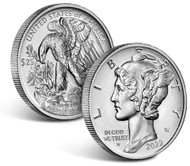2022-W American Palladium Eagle Launched
Posted by Bullion Shark on Sep 30th 2022
2022-W American Palladium Eagle Launched
In 2017 the United States Mint introduced an entirely new type of coin to its numismatic and bullion repertoire: the American Palladium Eagle, a coin made of one the rarest precious metals on earth and one whose spot price has risen to as much as $3,000 in recent years due to supply shortages and its widespread use in the automobile industry.
The new coin program was created in part to support the American palladium mining industry, which was based at the time at the Stillwater Mine in Montana and was much newer to the world of mining than its competitors in Russia and South Africa that have dominated the market. It was also an effort to prevent foreign mints, especially the Royal Canadian Mint, from dominating the world market for palladium coins.
A law was passed in 2010 creating the Palladium Eagle, which would be struck from .9995% pure palladium at the West Point Mint. It would feature designs created by the legendary coin designer and famed American-German sculptor Adolph Weinmann in which the obverse was taken from that of his famous Winged Liberty dime while the reverse was based on that of a gold medal he designed for the American Institute of Architects in 1908. In addition, the coins are struck in higher relief than most modern U.S. coins.
The program did not start right away because it required that a market study be done first, which found in 2013 that a collector coin program in which each’s years finish would differ from that of the prior year to the extent possible might be profitable, but a bullion program might not due to start-up costs. That is what happened when the coins actually debuted as bullion issues in 2017. Also, by the time the coins were issued the Stillwater Mine had been sold to a foreign mine owner and the palladium in the 2017 coins came from Switzerland. The coins sold out right away, and collectors loved them, but the Mint lost money on that program.
So the next year the Mint switched to collector versions sold at a much higher markup over the cost of the metal itself, which began with a Proof coin in 2018 followed in 2019 by the first Reverse Proof coin. An uncirculated issue that looks different from the 2017 bullion issue because it is struck on specially burnished planchets and has a “W” mint mark was issued in 2020. Then in 2021 a second Proof was released plus a second bullion coin.
Mintages have tended to decrease with this program since 2020, largely because the spot price of palladium that has been in the range of about $2000 to $3000 since 2020 has driven the retail cost the Mint charges for its coins to as much as $3,800 a coin in 2020.
On September 29, a second Reverse Proof Palladium Eagle was issued and priced initially at $3,050 with a household order limit of 10 coins and a mintage limit of 7,500 coins.
Reverse Proof coins tend to be popular with collectors. After the 2017 and 2018 Palladium Eagle mintages went downward due to availability of the metal, more coins were sold in 2019 when the Reverse Proof debuted.
According to media reports, as much as half of that maximum authorized mintage was sold to the Mint’s Authorized Bulk Purchaser Program. According to U.S. Mint spokesman Michael White Sept. 14, “For some products allocated to the ABPP program, we rely on historical offtake to define the amount of product allowed to this program. This is, for high value metals such as gold, platinum and palladium, higher than 10 percent. These products are typically purchased in quantity through our wholesale channels, of which ABPP is a significant part. The method for determining these allocations changes from year to year, as we continually review recent historical offtake. This year’s palladium is allocated to the ABPP at a level of slightly over 50 percent.”
Through this program, dealers can obtain the coins slightly in advance of their scheduled release at a premium and are required to pick them up in person. As it turned out, the ABPP dealers obtained 2,700 coins.
The new coin, like the 2019 issue, features a finish in which the traditional Proof finish that uses mirrored fields and frosted design elements is reversed, meaning the devices or foreground are mirrored, and the background is frosted. It is a striking appearance.
Interestingly, the Mint now says that these coins “cycle through” the Proof, Reverse Proof and uncirculated finishes.
Perhaps the Mint should consider some other finishes that would be different from the three used so far. For example, in the American Silver Eagle Program, they have used what they called an Enhanced Uncirculated finish in which certain parts of the design receive laser frosting to highlight those design elements. That finish was used in 2013 on a special Silver Eagle set.
Another option would be an Enhanced Reverse Proof, which the Mint used on the 2019-S and 2019-W Enhanced Reverse Proof Silver Eagle. According to the Mint, an Enhanced Reverse Proof (ERP) has the same frosted background as the RP, but different design finishes. The ERP has multiple polished and frosted finishes assigned to different isolated design elements, where the RP has only a single mirror like polished finish on the design. The selective polishing and frosting of the design elements of the ERP dramatically enhances the visual impact of the design.
If the Mint wants to inject some fresh interest into these coins in the future, it should consider using those other two finishes in future years on the American Palladium Eagle.


